人教版英语六年级上册各单元总结
(完整版)人教版六年级英语上册各单元知识点汇总
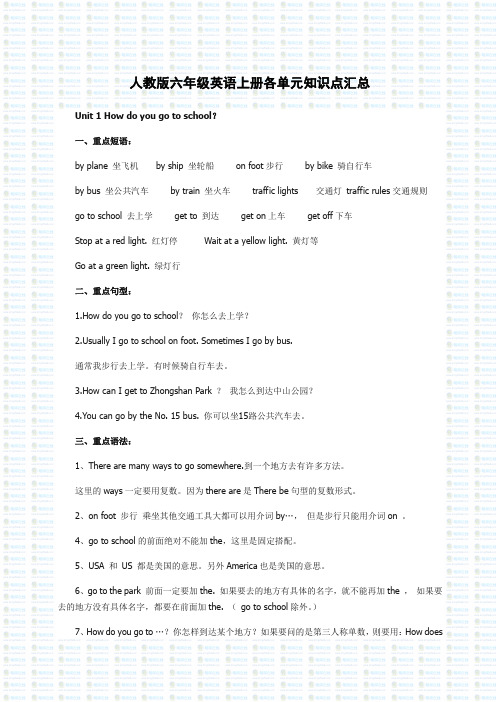
人教版六年级英语上册各单元知识点汇总Unit 1 How do you go to school?一、重点短语:by plane 坐飞机by ship 坐轮船on foot步行by bike 骑自行车by bus 坐公共汽车by train 坐火车traffic lights 交通灯traffic rules交通规则go to school 去上学get to 到达get on上车get off下车Stop at a red light. 红灯停Wait at a yellow light. 黄灯等Go at a green light. 绿灯行二、重点句型:1.How do you go to school?你怎么去上学?ually I go to school on foot. Sometimes I go by bus.通常我步行去上学。
有时候骑自行车去。
3.How can I get to Zhongshan Park ?我怎么到达中山公园?4.You can go by the No. 15 bus. 你可以坐15路公共汽车去。
三、重点语法:1、There are many ways to go somewhere.到一个地方去有许多方法。
这里的ways一定要用复数。
因为there are是There be句型的复数形式。
2、on foot 步行乘坐其他交通工具大都可以用介词by…,但是步行只能用介词on 。
4、go to school的前面绝对不能加the,这里是固定搭配。
5、USA 和US 都是美国的意思。
另外America也是美国的意思。
6、go to the park 前面一定要加the. 如果要去的地方有具体的名字,就不能再加the ,如果要去的地方没有具体名字,都要在前面加the. (go to school除外。
)7、How do you go to …?你怎样到达某个地方?如果要问的是第三人称单数,则要用:How doeshe/she…go to …?8、反义词:get on(上车)---get off(下车)near(近的)—far(远的)fast(快的)—slow(慢的)because(因为)—why(为什么)same(相同的)—different(不同的)9、近义词:see you---goodbye sure---certainly---of course10、频度副词:always 总是,一直usually 通常often经常sometimes 有时候never 从来不Unit 2 Where is the science museum?一、重点短语:library 图书馆post office 邮局hospital医院cinema 电影院bookstore书店science museum科学博物馆turn left向左转turn right 向右转go straight 直行north北south南east东west西next to靠近、与……。
人教版六年级英语上1-3单元重点总结
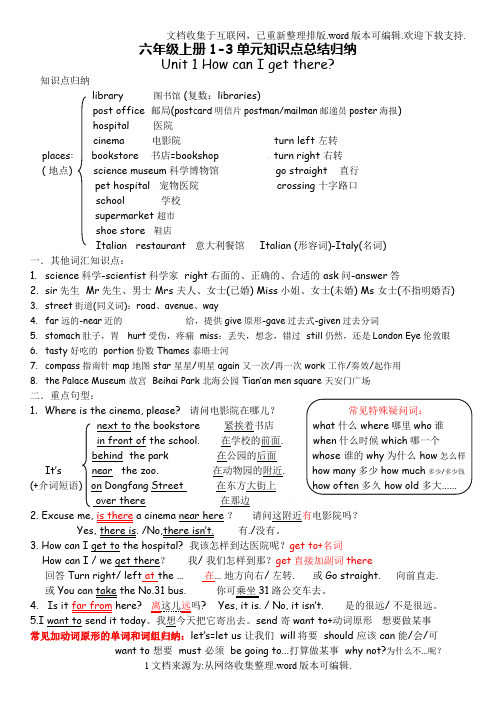
文档收集于互联网,已重新整理排版.word版本可编辑.欢迎下载支持.六年级上册1-3单元知识点总结归纳Unit 1 How can I get there?知识点归纳library 图书馆 (复数:libraries)post office 邮局(postcard明信片postman/mailman邮递员poster海报)hospital 医院cinema 电影院 turn left 左转places: bookstore 书店=bookshop m turn right 右转( 地点) science museum科学博物馆 go straight 直行pet hospital 宠物医院 crossing 十字路口school 学校supermarket 超市shoe store 鞋店Italian restaurant 意大利餐馆 Italian (形容词)-Italy(名词)一.其他词汇知识点:1.science科学-scientist科学家 right右面的、正确的、合适的 ask问-answer答2.sir先生 Mr先生、男士 Mrs 夫人、女士(已婚) Miss小姐、女士(未婚) Ms 女士(不指明婚否)3.street街道(同义词):road、avenue、way4.far远的-near近的给,提供 give原形-gave过去式-given过去分词5.stomach肚子,胃 hurt受伤,疼痛 miss:丢失,想念,错过 still仍然,还是London Eye伦敦眼6.tasty 好吃的 portion份数Thames 泰晤士河pass指南针 map 地图 star 星星/明星 again 又一次/再一次 work 工作/奏效/起作用8.the Palace Museum 故宫 Beihai Park 北海公园 Tian’an men square 天安门广场二.重点句型:1.Where is the cinema, please? 请问电影院在哪儿?next to the bookstore 紧挨着书店in front of the school. 在学校的前面. whenbehind the park 在公园的后面 whoseIt’s near the zoo. 在动物园的附近. how many(+介词短语) on Dongfang Street 在东方大街上 how oftenover there 在那边2. Excuse me, is there a cinema near here ?请问这附近有电影院吗?Yes, there is. /No,there isn’t.有./没有。
最新完整版人教版六年级英语上册总复习各单元知识点归纳总结及作文范文汇总
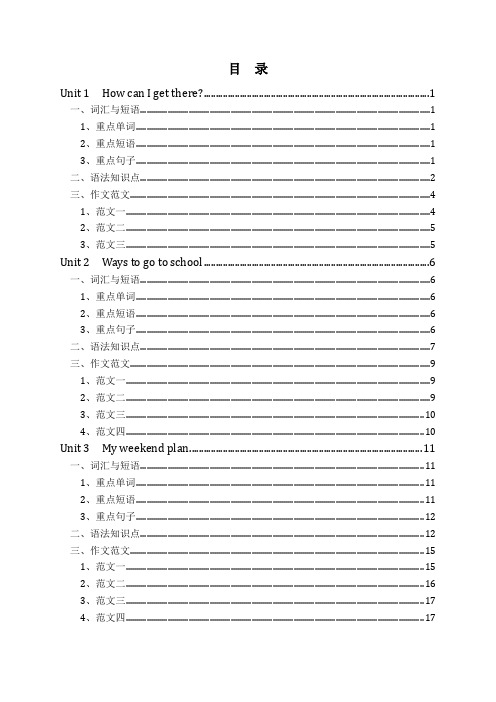
目录Unit 1 How can I get there? (1)一、词汇与短语 (1)1、重点单词 (1)2、重点短语 (1)3、重点句子 (1)二、语法知识点 (2)三、作文范文 (4)1、范文一 (4)2、范文二 (5)3、范文三 (5)Unit 2 Ways to go to school (6)一、词汇与短语 (6)1、重点单词 (6)2、重点短语 (6)3、重点句子 (6)二、语法知识点 (7)三、作文范文 (9)1、范文一 (9)2、范文二 (9)3、范文三 (10)4、范文四 (10)Unit 3 My weekend plan (11)一、词汇与短语 (11)1、重点单词 (11)2、重点短语 (11)3、重点句子 (12)二、语法知识点 (12)三、作文范文 (15)1、范文一 (15)2、范文二 (16)3、范文三 (17)4、范文四 (17)Unit 4 I have a pen pal (18)一、词汇与短语 (18)1、重点单词 (18)2、重点短语 (18)3、重点句子 (18)二、语法知识点 (19)三、作文范文 (23)1、范文一 (24)2、范文二 (24)3、范文三 (25)4、范文四 (25)Unit 5 What does he do (27)一、词汇与短语 (27)1、重点单词 (27)2、重点短语 (27)3、重点句子 (27)二、语法知识点 (28)三、作文范文 (30)1、范文一 (30)2、范文二 (31)3、范文三 (31)Unit 6 How do you feel (32)一、词汇与短语 (32)1、重点单词 (32)2、重点短语 (32)3、重点句子 (32)二、语法知识点 (33)三、作文范文 (34)1、范文一 (35)2、范文二 (35)3、范文三 (35)4、范文四 (35)语法知识点 (37)肯定句如何变否定句 (37)肯定句如何变一般疑问句 (39)划线部分提问(如何变特殊疑问句) (41)写作训练 (43)写作训练答案 (47)Unit 1 How can I get there?一、词汇与短语1、重点单词1.science /ˈsaɪəns/ 科学2.museum /mjuˈziːəm/ 博物馆3.post office /ˈpəʊst ɒfɪs/ 邮局4.bookstore /ˈbʊkstɔː/ 书店5.cinema /ˈsɪnəmə/ 电影院6.hospital /ˈhɒspɪtl/ 医院7.crossing /ˈkrɒsɪŋ/ 十字路口8.turn /tɜːn/ 转湾9.left /left/ 左10.right /raɪt/ 右11.straight /streɪt/ 笔直地12.ask /ɑːsk/ 问13.sir /sɜː(r)/ (对男子的礼貌称呼)先生14.interesting /ˈɪntrəstɪŋ/ 有趣的15.Italian /ɪˈtæliən/ 意大利的16.restaurant /ˈrestrɒnt/ 餐馆17.pizza /ˈpiːtsə/ 比萨饼18.street /striːt]/ 大街;街道19.get /get/ 到达20.gave /ɡeɪv/( give/ɡɪv/的过去式) 给21.follow /ˈfɒləʊ/ 跟着22.tell /tel/ 告诉2、重点短语1.science museum 科学博物馆2.near the library 图书馆附近3.get there 到达那里4.go straight 直走5.turn left/right 向左转/右转6.over there 在那边7.next to the museum 在博物馆旁边8.pet hospital 宠物医院9.Palace museum 故宫博物院10.in front of 在…前面11.behind the post office 在邮局后面12.beside the park 在公园旁边13.be far from 离……很远14.be far from home 远离家乡3、重点句子1. --Where is the museum shop?博物馆商店在哪里--It's near the door. 它在门附近。
人教版PEP小学英语六年级上册单元知识点总结
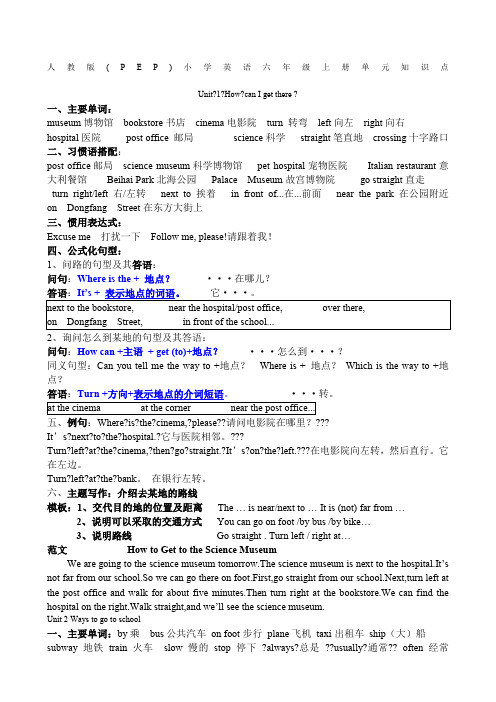
人教版(P E P)小学英语六年级上册单元知识点Unit?1?How?can I get there ?一、主要单词:museum博物馆bookstore书店cinema电影院turn 转弯left向左right向右hospital医院post office 邮局science科学straight笔直地crossing十字路口二、习惯语搭配:post office邮局science museum科学博物馆pet hospital宠物医院Italian restaurant意大利餐馆Beihai Park北海公园Palace Museum故宫博物院go straight直走turn right/left右/左转next to挨着in front of...在...前面near the park在公园附近on Dongfang Street在东方大街上三、惯用表达式:Excuse me 打扰一下Follow me, please!请跟着我!四、公式化句型:1、问路的句型及其答语:问句:Where is the + 地点?···在哪儿?答语:It’s + 表示地点的词语。
它···。
next to the bookstore, near the hospital/post office, over there,on Dongfang Street, in front of the school...2、询问怎么到某地的句型及其答语:问句:How can +主语+ get (to)+地点?···怎么到···?同义句型:Can you tell me the way to +地点?Where is + 地点?Which is the way to +地点?答语:Turn +方向+表示地点的介词短语。
人教版六年级英语上册各单元知识点汇总
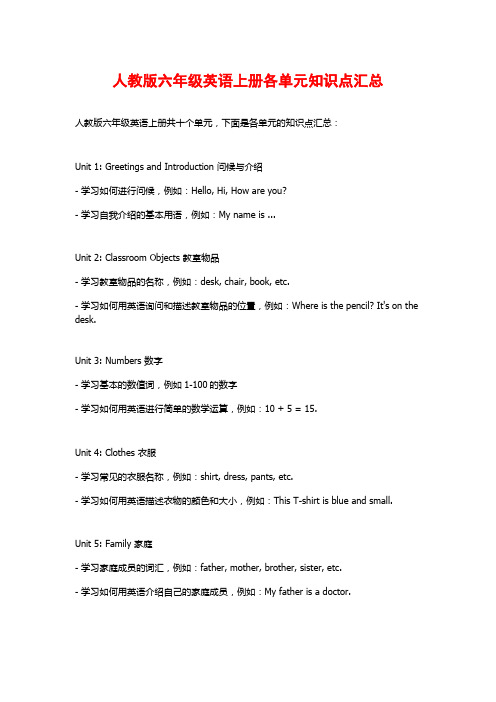
人教版六年级英语上册各单元知识点汇总人教版六年级英语上册共十个单元,下面是各单元的知识点汇总:Unit 1: Greetings and Introduction 问候与介绍- 学习如何进行问候,例如:Hello, Hi, How are you?- 学习自我介绍的基本用语,例如:My name is ...Unit 2: Classroom Objects 教室物品- 学习教室物品的名称,例如:desk, chair, book, etc.- 学习如何用英语询问和描述教室物品的位置,例如:Where is the pencil? It's on the desk.Unit 3: Numbers 数字- 学习基本的数值词,例如1-100的数字- 学习如何用英语进行简单的数学运算,例如:10 + 5 = 15.Unit 4: Clothes 衣服- 学习常见的衣服名称,例如:shirt, dress, pants, etc.- 学习如何用英语描述衣物的颜色和大小,例如:This T-shirt is blue and small.Unit 5: Family 家庭- 学习家庭成员的词汇,例如:father, mother, brother, sister, etc.- 学习如何用英语介绍自己的家庭成员,例如:My father is a doctor.Unit 6: Food 食物- 学习常见的食物名称,例如:apple, banana, bread, etc.- 学习如何用英语描述食物的味道和口感,例如:This banana is sweet and tasty.Unit 7: School Life 学校生活- 学习学校生活的用语,例如:go to school, have classes, play games, etc.- 学习如何用英语描述学校生活的常见活动,例如:I have English class at 9 o'clock.Unit 8: Hobbies and Free Time 爱好和业余时间- 学习常见的爱好词汇,例如:sing, dance, swim, etc.- 学习如何用英语询问和回答关于业余时间的问题,例如:What do you do in your free time? I like playing basketball.Unit 9: Daily Routine 日常生活- 学习描述日常活动的词汇,例如:get up, have breakfast, go to bed, etc.- 学习如何用英语描述自己的日常作息安排,例如:I get up at 7 o'clock in the morning.Unit 10: Travel and Places 旅行和地方- 学习关于旅行和地方的基本词汇,例如:train, bus, hotel, etc.- 学习如何用英语询问和指路,例如:Excuse me, how can I get to the post office? 希望对你有帮助!。
人教版PEP 英语六年级上册 全册各单元知识点总结
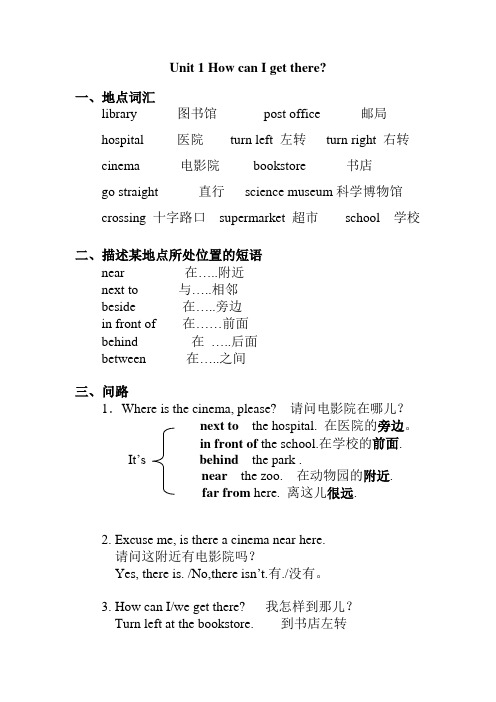
Unit 1 How can I get there?一、地点词汇library 图书馆post office 邮局hospital 医院turn left 左转turn right 右转cinema 电影院bookstore 书店go straight 直行science museum科学博物馆crossing 十字路口supermarket 超市school 学校二、描述某地点所处位置的短语near 在…..附近next to 与…..相邻beside 在…..旁边in front of 在……前面behind 在…..后面between 在…..之间三、问路1.Where is the cinema, please? 请问电影院在哪儿?next to the hospital. 在医院的旁边。
in front of the school.在学校的前面.It’s behind the park .near the zoo. 在动物园的附近.far from here. 离这儿很远.2. Excuse me, is there a cinema near here.请问这附近有电影院吗?Yes, there is. /No,there isn’t.有./没有。
3. How can I/we get there? 我怎样到那儿?Turn left at the bookstore. 到书店左转4. How can I get to the hospital? 我该怎样到达医院呢?Take the No.57 bus. 乘坐第57路公汽。
By the No. 57 bus.注意:到那儿get there到某地get to Canada/Australia/Beijing/ Shanghai/Wuhanget to the hospital/zoo/bookstore四、指引路1.You can take the No.32 bus.你可乘坐312路公交车去那儿.注意:You can go by the No.32 bus.与上句意思一样,只是说法不同。
小学六年级英语上册各单元知识点汇总(人教版)
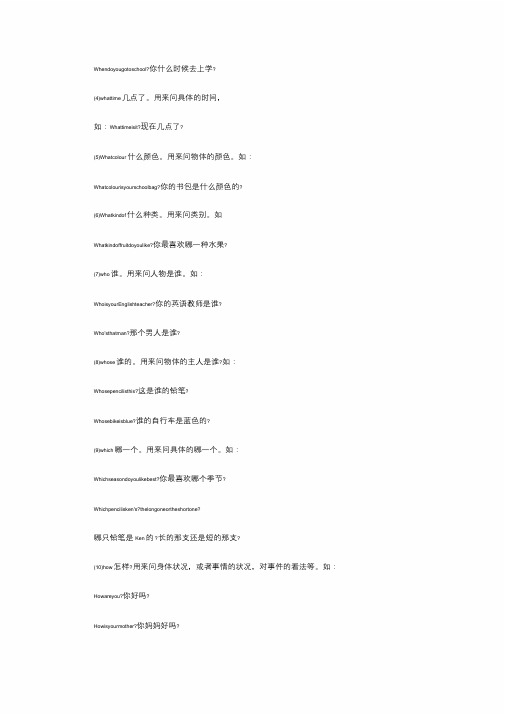
Whendoyougotoschool?你什么时候去上学?(4)whattime几点了。
用来问具体的时间,如:Whattimeisit?现在几点了?(5)Whatcolour什么颜色。
用来问物体的颜色。
如:Whatcolourisyourschoolbag?你的书包是什么颜色的?(6)Whatkindof什么种类。
用来问类别。
如Whatkindoffruitdoyoulike?你最喜欢哪一种水果?(7)who谁。
用来问人物是谁。
如:WhoisyourEnglishteacher?你的英语教师是谁?Who'sthatman?那个男人是谁?(8)whose谁的。
用来问物体的主人是谁?如:Whosepencilisthis?这是谁的铅笔?Whosebikeisblue?谁的自行车是蓝色的?(9)which哪一个。
用来问具体的哪一个。
如:Whichseasondoyoulikebest?你最喜欢哪个季节?Whichpencilisken's?thelongoneortheshortone?哪只铅笔是Ken的?长的那支还是短的那支?(10)how怎样?用来问身体状况,或者事情的状况,对事件的看法等。
如:Howareyou?你好吗?Howisyourmother?你妈妈好吗?(11)howmany多少个。
用来问有多少个,后面要跟名词的复数形式。
如:Howmanybooksdoyouhave?你有多少本书?Howmanykitescanyousee?你能看见多少只风筝?(12)howmuch多少钱。
用来问物体的价钱。
如:Howmucharethey?他们多少钱?Howmuchisyourschoolbag?你的书包多少钱?(13)howold几岁了。
用来问年龄。
如Howoldareyou?你几岁了?Howoldisyourfather?你爸爸多大了?(14)why为什么。
用来问原因,一般要用because来答复。
人教版小学英语六年级上册各单元知识点
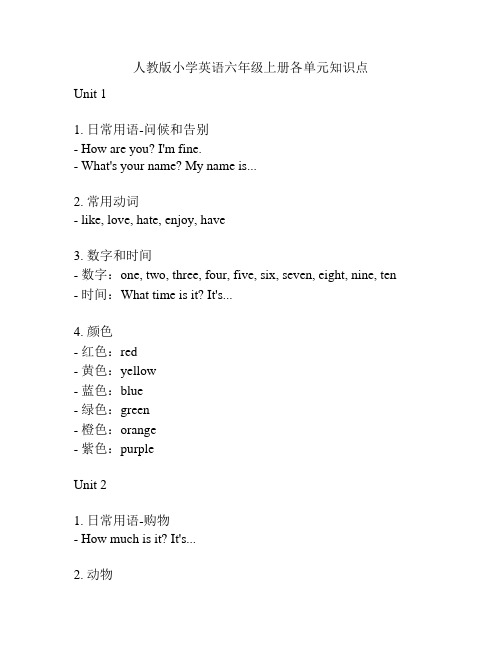
人教版小学英语六年级上册各单元知识点Unit 11. 日常用语-问候和告别- How are you? I'm fine.- What's your name? My name is...2. 常用动词- like, love, hate, enjoy, have3. 数字和时间- 数字:one, two, three, four, five, six, seven, eight, nine, ten - 时间:What time is it? It's...4. 颜色- 红色:red- 黄色:yellow- 蓝色:blue- 绿色:green- 橙色:orange- 紫色:purpleUnit 21. 日常用语-购物- How much is it? It's...2. 动物- 狗:dog- 鸟:bird- 鱼:fish- 熊猫:panda- 大象:elephant3. 食物- 苹果:apple- 香蕉:banana- 面包:bread- 糖果:candy- 葡萄:grape- 冰淇淋:ice cream4. 数量- 单数:one, two, three, four, five - 复数:six, seven, eight, nine, tenUnit 31. 日常用语-介绍人- This is my friend. His name is...2. 学科- 数学:math- 英语:English- 音乐:music- 体育:PE3. 预备动词- can, can't, must4. 职业- 医生:doctor- 教师:teacher- 消防员:firefighter- 安保人员:security guard- 演员:actorUnit 41. 日常用语-问路和指路- Excuse me. Where is the...? It's over there.2. 季节和天气- 春天:spring- 夏天:summer- 秋天:fall- 冬天:winter3. 身体部位- 头:head- 手:hand- 脚:foot- 膝盖:knee- 肩膀:shoulder4. 方位词- 上方:above- 下方:below- 前方:in front of- 后方:behind- 旁边:next toUnit 51. 日常用语-约会和度假- Would you like to...? Yes, I'd love to.2. 运动和活动- 游泳:swim- 跑步:run- 跳绳:jump rope- 弹吉他:play the guitar- 看电影:watch movies3. 服装和颜色- 衬衫:shirt- 裤子:pants- 运动鞋:sneakers- 黑色:black- 白色:white4. 手表和日历- 时间:What time is it? It's...- 日期:What's the date today? It's...Unit 61. 日常用语-邀请和礼仪- Please come to my party. Thank you for inviting me.2. 家庭成员和描述- 爸爸:dad- 妈妈:mom- 姐姐:sister- 哥哥:brother- 孩子:child3. 饮料和食物- 牛奶:milk- 咖啡:coffee- 汉堡:hamburger- 面条:noodles- 披萨:pizza4. 介绍自己- My name is... I'm from... I like...Unit 1:在日常生活中,问候和告别是必不可少的。
人教版英语六年级上册各单元总结提纲
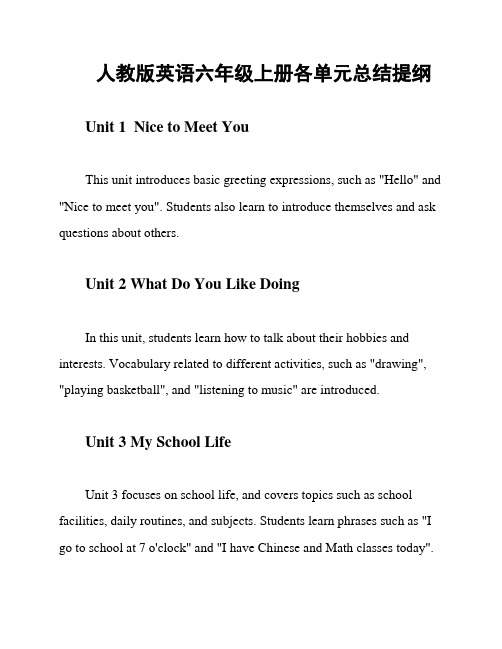
人教版英语六年级上册各单元总结提纲Unit 1 Nice to Meet YouThis unit introduces basic greeting expressions, such as "Hello" and "Nice to meet you". Students also learn to introduce themselves and ask questions about others.Unit 2 What Do You Like DoingIn this unit, students learn how to talk about their hobbies and interests. Vocabulary related to different activities, such as "drawing", "playing basketball", and "listening to music" are introduced.Unit 3 My School LifeUnit 3 focuses on school life, and covers topics such as school facilities, daily routines, and subjects. Students learn phrases such as "I go to school at 7 o'clock" and "I have Chinese and Math classes today".Unit 4 My FamilyIn this unit, students learn vocabulary related to family members such as "father", "mother", "grandpa", and "grandma". They also learn how to talk about family members' occupations and daily routines.Unit 5 On the FarmUnit 5 teaches students about animals and life on the farm. Vocabulary related to different farm animals such as "cow", "duck", "sheep", and "chicken" are introduced. Students also learn how to describe various actions of the animals.Unit 6 At the TableThis unit teaches students vocabulary related to food and mealtimes, such as "breakfast", "lunch", and "dinner". Students also learn to express their food preferences and ask about others' preferences.Conclusion。
人教版PEP英语六年级上册知识点归纳

Unit 1 How can I get there?1. 名词: science 科学 museum 博物馆 bookstore 书店 cinema 电影院 hospital 医院 crossing 十字路口2. 动词: turn 转弯3. 副词: left 左 right 右 straight 笔直地4. 短语: post office 邮局1. 名词: sir 先生 restaurant 餐馆 pizza 比萨饼 street 大街;街道 GPS 全球(卫星)定位系统2. 动词: ask 问 feature 特点 get 到达 gave(give 的过去式) 供给;交给 follow跟着tell 告知3. 形容词: interesting 好玩的 Italian 意大利的 far 较远的1. — Where is the cinema? 电影院在哪儿?— It ’ns e xt to the bookstore. 紧挨着书店。
2. How can we get there?我们怎么到那儿?3. Turn left at the bookstore. Then turn right at the hospital.到书店左转。
然后到医院右转。
留意:要留意介词的固定搭配。
Turn left/right at the … 到……左/右转。
Get off at the … 在……下车。
一、核心词汇二、了解词汇三、核心句型It’s on the left/right.在左/右边。
Walk/Go straight for …minutes.步行/直走……分钟。
It’seast/west/south/north of the …在……东/西/南/北边。
It’sfar from the …距离……远。
四、了解句型1.Is there a …?……有……吗?拓展: there be 句型(1)主要用以表达“某处(某时)有某人(某物)”,其根本句型为“There+be 动词+名词+介词短语+其他.”There is a football under the chair. 椅子下面有一个足球。
人教版PEP 英语六年级上册 全册各单元知识点总结

人教版PEP 英语六年级上册全册各单元知识点总结Unit 1 How can I get there?一、地点词汇在问路时,掌握一些地点词汇是必要的,这些词汇包括library(图书馆)、post office(邮局)、XXX)、cinema(电影院)、bookstore(书店)、supermarket(超市)、school (学校)等等。
二、描述某地点所处位置的短语在描述某地点所处位置时,可以使用一些短语,如near (在…。
附近)、next to(与…。
相邻)、XXX(在…。
旁边)、in front of(在……前面)、behind(在…。
后面)、een(在…。
之间)等等。
三、问路当我们不知道某个地方在哪儿时,可以问路。
问路时,我们可以使用一些常用的句型,如“Where is the cinema。
please?”(请问电影院在哪儿?)、“Excuse me。
is there a cinema near here?”(请问这附近有电影院吗?)、“How can I get there?”(我怎样到那儿?)等等。
四、指引路当我们知道了某个地方的位置后,我们需要指引路。
指引路时,我们可以使用一些常用的短语,如“You can take the No.32 bus.”(你可乘坐312路公交车去那儿)、“Go straight and turn left at the bookstore.”(先直行然后在书店那儿左转弯)、“Turn right/ left at the …”(在…地方向右/左转)等等。
Unit 2: Ways to Go to SchoolDo you live far from school。
You may need to choose a XXX method to get there。
Here are some common n tools you can use: bike。
人教版(PEP)小学英语六年级上册各单元知识点归纳(三年级起点)
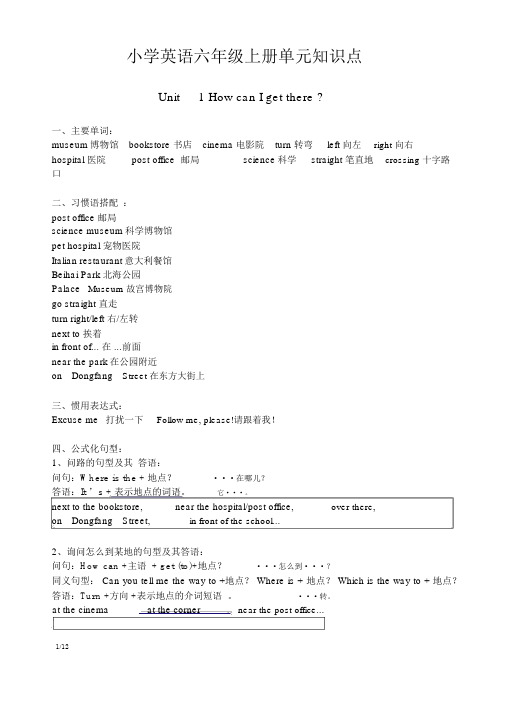
小学英语六年级上册单元知识点Unit 1 How can I get there ?一、主要单词:museum博物馆bookstore 书店cinema 电影院turn 转弯left 向左right 向右hospital 医院post office 邮局science科学straight 笔直地crossing 十字路口二、习惯语搭配:post office 邮局science museum科学博物馆pet hospital 宠物医院Italian restaurant意大利餐馆Beihai Park 北海公园Palace Museum 故宫博物院go straight 直走turn right/left 右/左转next to 挨着in front of... 在 ...前面near the park在公园附近on Dongfang Street 在东方大街上三、惯用表达式:Excuse me打扰一下Follow me, please!请跟着我!四、公式化句型:1、问路的句型及其答语:问句:Where is the + 地点?···在哪儿?答语:It ’s + 表示地点的词语。
它···。
next to the bookstore,near the hospital/post office,over there,on Dongfang Street,in front of the school...2、询问怎么到某地的句型及其答语:问句:How can +主语 + get (to)+地点?···怎么到···?同义句型: Can you tell me the way to +地点? Where is + 地点? Which is the way to + 地点?答语:Turn +方向 +表示地点的介词短语。
(完整word版)PEP人教版六年级英语上册各单元复习要点
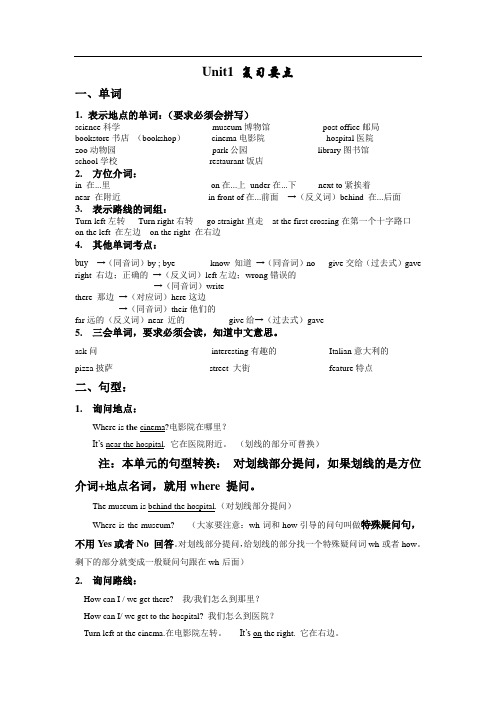
Unit1 复习要点一、单词1.表示地点的单词:(要求必须会拼写)science科学museum博物馆post office邮局bookstore书店(bookshop)cinema电影院hospital医院zoo动物园park公园library图书馆school学校restaurant饭店2.方位介词:in 在...里on在...上under在...下next to紧挨着near 在附近in front of在...前面→(反义词)behind 在...后面3.表示路线的词组:Turn left左转Turn right右转go straight直走at the first crossing在第一个十字路口on the left 在左边on the right 在右边4.其他单词考点:buy →(同音词)by ; bye know 知道→(同音词)no give交给(过去式)gave right 右边;正确的→(反义词)left左边;wrong错误的→(同音词)writethere 那边→(对应词)here这边→(同音词)their他们的far远的(反义词)near 近的give给→(过去式)gave5.三会单词,要求必须会读,知道中文意思。
ask问interesting有趣的Italian意大利的pizza披萨street 大街feature特点二、句型:1.询问地点:Where is the cinema?电影院在哪里?It’s near the hospital. 它在医院附近。
(划线的部分可替换)注:本单元的句型转换:对划线部分提问,如果划线的是方位介词+地点名词,就用where 提问。
The museum is behind the hospital.(对划线部分提问)Where is the museum? (大家要注意:wh-词和how引导的问句叫做特殊疑问句,不用Yes或者No 回答。
人教版六年级英语上册知识点重点难点考点汇总
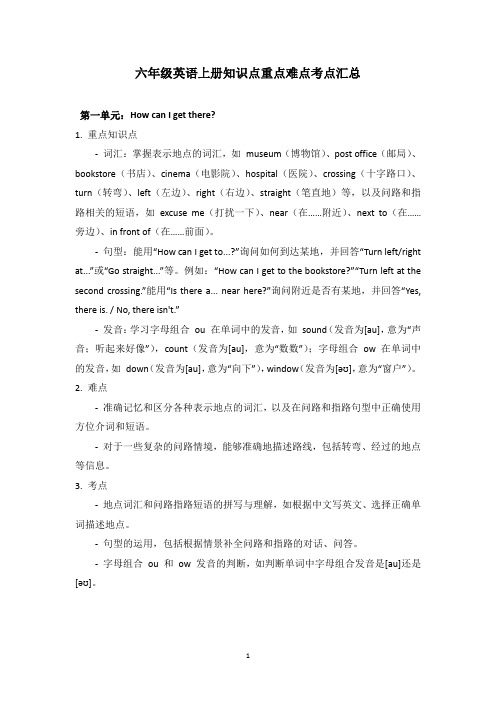
六年级英语上册知识点重点难点考点汇总第一单元:How can I get there?1. 重点知识点-词汇:掌握表示地点的词汇,如museum(博物馆)、post office(邮局)、bookstore(书店)、cinema(电影院)、hospital(医院)、crossing(十字路口)、turn(转弯)、left(左边)、right(右边)、straight(笔直地)等,以及问路和指路相关的短语,如excuse me(打扰一下)、near(在……附近)、next to(在……旁边)、in front of(在……前面)。
-句型:能用“How can I get to...?”询问如何到达某地,并回答“Turn left/right at...”或“Go straight...”等。
例如:“How can I get to the bookstore?”“Turn left at the second crossing.”能用“Is there a... near here?”询问附近是否有某地,并回答“Yes, there is. / No, there isn't.”-发音:学习字母组合ou 在单词中的发音,如sound(发音为[au],意为“声音;听起来好像”),count(发音为[au],意为“数数”);字母组合ow 在单词中的发音,如down(发音为[au],意为“向下”),window(发音为[əʊ],意为“窗户”)。
2. 难点-准确记忆和区分各种表示地点的词汇,以及在问路和指路句型中正确使用方位介词和短语。
-对于一些复杂的问路情境,能够准确地描述路线,包括转弯、经过的地点等信息。
3. 考点-地点词汇和问路指路短语的拼写与理解,如根据中文写英文、选择正确单词描述地点。
-句型的运用,包括根据情景补全问路和指路的对话、问答。
-字母组合ou 和ow 发音的判断,如判断单词中字母组合发音是[au]还是[əʊ]。
人教版六年级英语上册Unit1-Unit6知识总结

Unit1 总结单词/短语:science museum 科学博物馆post office 邮局bookstore 书店cinema 电影院hospital 医院crossing 十字路口turn left 向左转turn right 向右转go straight 直走near 在附近,距离不远next to 与…相邻的,紧挨着的behind 在…后面in front of 在…前面work 工作;起作用,奏效want 想,想要shop 商店buy 买postcard 明信片send 邮寄; 发送know 知道ask 问answer 回答beside 在…旁边(与near,next to意思相近)a talking robot 一个会说话的机器人great 很棒的between 在两者之间interesting 令人感兴趣的;有趣的; 有吸引力的(interested感兴趣的; 关心的; 表现出兴趣的) hungry 饿的full 饱的restaurant 饭店;餐厅street 街道first 首先,先;第一的watch/see a film/movie 看电影Let me 让我Let us=Let’s 让我们I will=I’ll 我会,我将要句型:①Where is/are the …(+地点/物/人) ? (以where引导的特殊疑问句)…在哪?It’near/next to/behind/in front of the …它在…(回答一般具体化,回答内容不回答yes和no)e.g. Where is the hospital? 医院在哪里?It’s next to the bookstore. 他在书店的旁边。
Where are they?/Where is she? 他们在哪?/她在哪?They are in the park.他们在公园。
/She is in the bedroom. 她在房间里。
人教版六上英语期末总结

人教版六上英语期末总结第一单元:My school day本单元主要围绕着学生的校园生活展开,学习了一些关于日常生活的常用表达和句型,例如:“get up, have breakfast, go to school” 等等。
同时也学习了一些学科的英文名字,例如:“Chinese, math, science” 等等,通过这些学习,帮助学生了解校园生活和学科的基本术语。
第二单元:My family在这个单元中,学生通过学习有关家人的内容,培养了自己介绍家庭成员和家人关系的能力。
同时也学习了一些家庭成员的称谓,例如:“grandmother, grandfather, aunt, uncle” 等等。
通过这些内容的学习,学生们能够更好地描述自己的家庭和家人。
第三单元:My weekend这个单元主要介绍了学生们在周末所做的事情,学生们通过学习一些常用动词和短语,如:“play basketball, fly kites, visit grandparents” 等等,能够更好地描述自己的周末活动,同时也拓宽了学生们的词汇量。
第四单元:My schoolbag学生们通过学习描述物品的形容词和介词,如:“big, small, in, on”等等,学会了描述自己的学习用品。
同时,还学习了一些词汇和短语,如:“pen, pencil, ruler, eraser” 等等,使学生们能够更好地表达自己的学习需求。
第五单元:My classroom这个单元着重介绍了学生们的教室环境和教具设备。
学生们学会了补充教室所缺少的物品,并描述教室的基本布置,如:“There are many books in t he bookshelf. The teacher's desk is in front of the blackboard.” 等等。
学生们通过这个单元的学习,能够更好地描述自己的教室环境。
第六单元:My body学生们通过学习描述身体部位的词汇,如:“head, eyes, nose, mouth” 等等,学会了描述自己和他人的身体部位。
人教版小学六年级上册英语知识点总结归纳
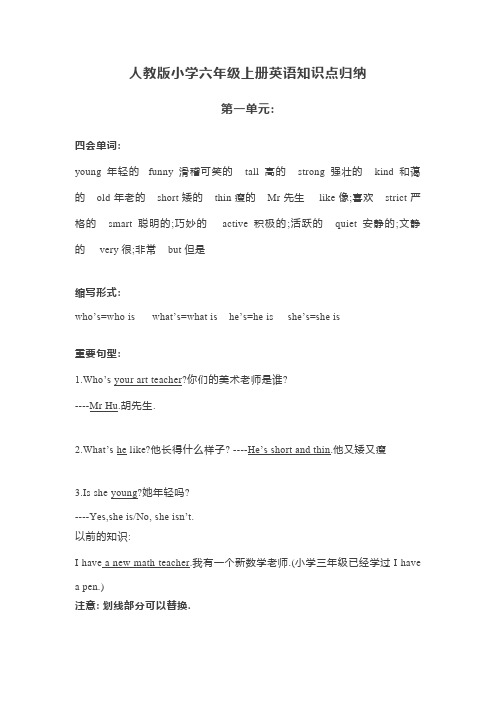
人教版小学六年级上册英语知识点归纳第一单元:四会单词:young年轻的funny滑稽可笑的tall高的strong强壮的kind和蔼的old年老的short矮的thin瘦的Mr先生like像;喜欢strict严格的smart聪明的;巧妙的active积极的;活跃的quiet安静的;文静的very很;非常but但是缩写形式:who’s=who is what’s=what is he’s=he is she’s=she is重要句型:1.Who’s your art teacher?你们的美术老师是谁?----Mr Hu.胡先生.2.What’s he like?他长得什么样子? ----He’s short and thin.他又矮又瘦3.Is she young?她年轻吗?----Yes,she is/No, she isn’t.以前的知识:I have a new math teacher.我有一个新数学老师.(小学三年级已经学过I havea pen.)注意: 划线部分可以替换.第二单元:四会单词:Monday 星期一 Tuesday星期二Wednesday星期三 Thursday星期四Friday 星期五Saturday星期六 Sunday 星期日day天;日子have有;吃on 在……时候too也;太短语:do homework 做作业watch TV 看电视read books 读书What about? ......怎么样?do housework 做家务play computer games 玩电脑游戏重点句型:1.What day is it today?今天星期几?—It’s Monday.星期一.2. What do we have on Mondays?星期一我们有什么课?—We have English,science,computer and P.E.我们有英语课,科学,计算机跟体育课.3.What do you do on Saturdays?星期六你干什么?(具体的某一天前用介词on,在具体的时间前,用介词at)—I often do my homework.我通常做家庭作业.4.What about you?你呢?—I do my homework,too.我也是做家庭作业.第三单元:四会单词:eggplant 茄子fish 鱼green beans 青豆tofu 豆腐potato 土豆tomato 西红柿for 为;给lunch 中餐;午饭we 我们tasty 好吃的;可口的sweet 甜的sour 酸的fresh 新鲜的salty 咸的favourite 最喜爱的;特别喜爱的fruit 水果grape 葡萄缩写形式:they’re=they are don’t=do not重点句型:1.What would you like for lunch?你午餐想吃什么?-----I’d like some tomatoes and mutton.我想吃一些西红柿跟羊肉.2.What’s your favourite fruit?你最喜欢的水果是什么?------/I like apples.我喜欢苹果.3.I don’t like grapes.我不喜欢葡萄.4.Bananas are my favourite.我最喜欢香蕉.第四单元一. 单词:empty the trash倒垃圾cook the meals 做饭water the flowers浇花sweep the floor扫地clean the bedroom打扫卧室make the bed铺床set the table摆餐具wash the clothes洗衣服do the dishes洗碗碟put away the clothes收拾衣服can’t = cannot(不会;不能)use a computer(使用计算机)二. 句子:1. I’m helpful!I can sweep the floor。
(完整版)人教版六年级英语上册各单元知识点汇总

人教版六年级英语上册各单元知识点汇总Unit 1 How do you go to school?一、重点短语:by plane 坐飞机by ship 坐轮船on foot步行by bike 骑自行车by bus 坐公共汽车by train 坐火车traffic lights 交通灯traffic rules交通规则go to school 去上学get to 到达get on上车get off下车Stop at a red light. 红灯停Wait at a yellow light. 黄灯等Go at a green light. 绿灯行二、重点句型:1.How do you go to school?你怎么去上学?ually I go to school on foot. Sometimes I go by bus.通常我步行去上学。
有时候骑自行车去。
3.How can I get to Zhongshan Park ?我怎么到达中山公园?4.You can go by the No. 15 bus. 你可以坐15路公共汽车去。
三、重点语法:1、There are many ways to go somewhere.到一个地方去有许多方法。
这里的ways一定要用复数。
因为there are是There be句型的复数形式。
2、on foot 步行乘坐其他交通工具大都可以用介词by…,但是步行只能用介词on 。
4、go to school的前面绝对不能加the,这里是固定搭配。
5、USA 和US 都是美国的意思。
另外America也是美国的意思。
6、go to the park 前面一定要加the. 如果要去的地方有具体的名字,就不能再加the ,如果要去的地方没有具体名字,都要在前面加the. (go to school除外。
)7、How do you go to …?你怎样到达某个地方?如果要问的是第三人称单数,则要用:How does he/she…go to …?8、反义词:get on(上车)---get off(下车)near(近的)—far(远的)fast(快的)—slow(慢的)because(因为)—why(为什么)same(相同的)—different(不同的)9、近义词:see you---goodbye sure---certainly---of course10、频度副词:always 总是,一直usually 通常often经常sometimes 有时候never 从来不Unit 2 Where is the science museum?一、重点短语:library 图书馆post office 邮局hospital医院cinema 电影院bookstore书店science museum科学博物馆turn left向左转turn right 向右转go straight 直行north北south南east东west西next to靠近、与……。
- 1、下载文档前请自行甄别文档内容的完整性,平台不提供额外的编辑、内容补充、找答案等附加服务。
- 2、"仅部分预览"的文档,不可在线预览部分如存在完整性等问题,可反馈申请退款(可完整预览的文档不适用该条件!)。
- 3、如文档侵犯您的权益,请联系客服反馈,我们会尽快为您处理(人工客服工作时间:9:00-18:30)。
人教版(PEP)小学英语六年级上册单元知识点Unit1 How can I get there ?一、主要单词:museum博物馆bookstore书店cinema电影院turn 转弯left向左right向右hospital医院post office 邮局science科学straight笔直地crossing十字路口二、习惯语搭配:post office邮局science museum科学博物馆pet hospital宠物医院Italian restaurant意大利餐馆Beihai Park北海公园Palace Museum故宫博物院go straight直走turn right/left右/左转next to挨着in front of...在...前面near the park在公园附近on Dongfang Street在东方大街上三、惯用表达式:Excuse me 打扰一下Follow me, please!请跟着我!四、公式化句型:1、问路的句型及其答语:问句:Where is the + 地点?···在哪儿?2、询问怎么到某地的句型及其答语:问句:How can +主语+ get (to)+地点?···怎么到···?同义句型:Can you tell me the way to +地点?Where is + 地点?Which is the way to +地点?五、例句:Where is the cinema, please? 请问电影院在哪里?It’s next to the hospital. 它与医院相邻。
Turn left at the cinema, then go straight. It’s on the left. 在电影院向左转,然后直行。
它在左边。
Turn left at the bank。
在银行左转。
六、主题写作:介绍去某地的路线模板:1、交代目的地的位置及距离The … is near/next to … It is (not) far from …2、说明可以采取的交通方式You can go on foot /by bus /by bike…3、说明路线Go straight . Turn left / right at…范文How to Get to the Science MuseumWe are going to the science museum tomorrow.The science museum is next to the hospital.It’s not far from our school.So we can go there on foot.First,go straight from our school.Next,turn left at the post office and walk for about five minutes.Then turn right at the bookstore.We can find the hospital on the right.Walk straight,and we’ll see the science museum.Unit 2 Ways to go to school一、主要单词:by乘bus公共汽车on foot步行plane飞机taxi出租车ship(大)船subway地铁train火车slow慢的stop停下 always 总是 usually 通常often经常sometimes 有时候never 从来不二、习惯语搭配:by bike/bus/plane/subway/train/ship/taxi/ferry 骑自行车/乘公共汽车/飞机/地铁/火车/船/出租汽车/渡轮take the No.57 bus乘57路公共汽车on foot步行slow down慢下来pay attention to注意traffic lights 交通信号灯look right向右看cross the road横穿马路get off下车at home在家traffic rules交通规则 get to到达get on 上车be far from…表示离某地远三、惯用表达式:Wait.等一等. I see. 我明白了. Go at a green light 绿灯行Stop at a red light 红灯停Wait at a yellow light 黄灯等四、公式化句型:1、如何询问对方的出行方式:How do you come(to)+地点?你(们)怎么来···的?2、如何用must表示必须做某事:某人+must+动词原形(+其它). ···必须···。
3、告诫别人不要做某事的句型:Don’t +动词原形(+其它). .不要/别···。
五、例句:1. How do you go to school? 你怎么去上学?2. Usually I go to school on foot. Sometimes I go by bus. 通常我步行去上学。
有时候骑自行车去。
3. How can I get to Zhongshan Park ? 我怎么到达中山公园?4. You can go by the No. 15 bus. 你可以坐15路公共汽车去。
5. I am far from school now. 我现在离学校很远。
6. My home is not far from our school. My home is near our school.我家离学校不远。
六、主题写作:介绍去上学所采用的出行方式模板:1、说明自己家到学校的距离My home is (not) far from /near the school.2、说明自己的出行方式I often /usually go to school … Sometimes I go …3、说明选择该出行方式的原因或好处It is good exercise./It is fast.范文Don’t Be Against the Traffic RulesI go to school from Mondays to Fridays. I go to school by bike at 7:30 in the morning.I have to cross two busy roads.I know the traffic rules well.Slow down and stop at a yellow light.Stop and wait at a red light.Go at a green light.I always ride on the right side of the road.I am never against the traffic rules.Unit 3 My weekend plan一、主要单词:tomorrow明天film电影supermarket超市trip旅行tonight在今晚evening晚上/傍晚next week下周comic连环画杂志dictionary词典word单词post card明信片visit拜访二、习惯搭配:take a trip去旅行go for a picnic去野餐go to the cinema去看电影learn to swim学习游泳visit my grandparents看望我(外)祖父母get together 聚会go to the supermarket去超市go ice-skating去滑冰make a snowman堆雪人see a film看电影make mooncakes做月饼read a poem朗诵一首诗this weekend这周末Renmin Park人民公园next week下周this morning/afternoon/evening今天上午/下午/晚上next Wednesday下星期三三、惯用表达式:What about you?你呢?Here they are!它们在这儿!Can I help you? 我能帮助你吗?Sounds great!听起来很棒!Have a good time!玩得开心!You too.你也是四、公式化句型:1、询问对方打算做什么的句型及其答语:2、询问对方打算去哪儿的句型及答语:问句:Where are you going(+将来时间)? 你/你们打算(···)去哪儿?答语:I’m/We’re going (to the)+地点. 我/我们打算去···。
3、询问对方打算何时去做某事的句型及答语:问句:When are you going to +动词(短语)原形?你/你们打算什么时候···?答语:I’m/We’re going to +动词(短语)原形+将来时间. 我/我们打算···。
五、例句:What are you going to do on the weekend? 你周末打算做什么?I’m going to visit my grandparents this weekend? 这个周末我打算去看望我的外祖父母。
Where are you going this afternoon? 你今天下午打算去哪里?I’m going to the bookstore. 我打算去书店。
What are you going to buy? 你打算去买什么?I’m going to buy a comic book。
我打算去买一本漫画书。
六、主题写作:制订周末计划模板:1、说明一下自己打算过个怎样的周六I am going to have a busy/great/… day.2、按时间顺序,介绍自己打算做的事I’m going to +动词(短语)原形+将来的时间。
范文Let’s Have a Nice Day!Today is Saturday.Tomorrow morning I’m going to the bookstore with my friends.We are going to look for some good books.We all like reading books.We are going to have lunch in a restaurant.I like chicken,beef and vegetables.After lunch,we are going to the Summer Palace by bus.We are going to play near the Kunming Lake.Maybe we are going to row a boat on the lake.That will be great!We are coming back at 5 in the afternoon.Unit 4 I have a pen pal一、主要单词:studies学习(第三人称单数形式)puzzle谜hiking远足二、习惯搭配:read stories读故事do kungfu练功夫fly kites放风筝play the pipa弹琵琶play sports进行体育活动climb mountains爬山listen to music听音乐sing English songs唱英文歌on a farm在一个农场里live in...住在···write an email to...给···写一封电子邮件on the playground在运动场上三、惯用表达式:Me too.我也是。
